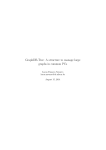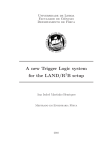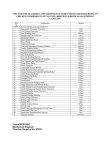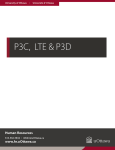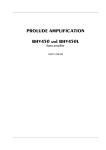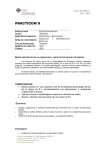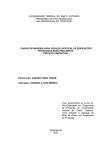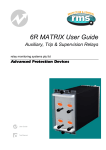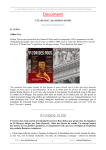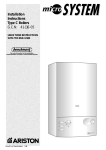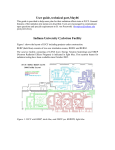Download User Manual
Transcript
ThiMeT: Thickness Measurement Tools for SRIM v1.0 Caner YALÇIN www. ThiMeT.org ThiMeT is a code for thickness calculation using SRIM (www.srim.org) stopping power values. ThiMeT code can be also used for the determination of the required thickness for energy degraders which are needed for nuclear reactions. ThiMeT calculation is very easy and quick compared to the TRIM code calculation. ThiMeT code also contains TTEC Module for calculation of the average transmission energy from the TRIM output file “transmit.txt”. Please cite ThiMeT code as “C. Yalçın, “Thickness measurement using alpha spectroscopy and SRIM”, J. Phys.: Conf. Ser. 590, 012050 (2015); http://www.thimet.org” Contents 1. Introduction................................................................................................................. 2 2. Installation of ThiMeT ............................................................................................ 2 3. Running ThiMeT code ………………………………………..................................... 2 4. Verification ………...................................................................................................... 3 5. Limitation ………………………………………............................................................. 3 6. Measurement of Thickness …..………………...................................................... 4 7. Comparison with TRIM.......................................................................................... 5 8. TTEC Code ................................................................................................................... 6 9. References.................................................................................................................... 6 License This program is free software: you can redistribute it freely. This program is distributed in the hope that it will be useful, but WITHOUT ANY WARRANTY; without even the implied warranty of MERCHANTABILITY or FITNESS FOR A PARTICULAR PURPOSE. For commercial use please contact with www.ThiMeT.org Doc. ver. 2.1 ThiMeT : Thickness Measurement Tools for SRIM www. ThiMeT.org Introduction ThiMeT is a code for thickness calculation using SRIM [1] stopping power values. ThiMeT code can be also used for the determination of the required thickness for energy degraders which are needed for nuclear reactions. ThiMeT calculations are very easy and quick compared to the TRIM code calculations. Thickness of a material can be calculated by measuring energy loss through matter if the stopping power of the material is well known [2]. This method widely uses to measure energy degrader, backing and target thickness for nuclear reactions experiments [3,4]. However the ions continuously lose their energy as they move through matter, and also stopping power changes because of its energy dependent nature. For this reason, when calculting the thickness, one must take into account this effect, especially for the thick material. ThiMeT code takes into account stopping power changes through matter and calculates the accurate thickness by using SRIM [1]. ThiMeT code also can be used for the determination of the required thickness for energy degraders. This is often used for light ions, such as protons, to obtain lower energies quickly [5,6,7,8]. Please note that ThiMeT code actually use SR Module in the SRIM and the nuclear stopping powers of SR Module are slightly different from those in the full tables since these are improved values which will later be incorporated into SRIM [1]. Installation of ThiMeT Because of the ThiMeT code uses SRIM code, first you should install it. SRIM code can be downloading from www.srim.org. After the installation of the SRIM, download the ThiMeT code (www.thimet.org) for appropriate platform which you use. Extract the zip file and copy the ThiMeT code folder wherever you want. This folder includes “Docs”, “OUT_ThiMeT” and “OUT_TTEC” sub-folders and also “ThiMeT.exe”, “TTEC.exe” and “SRIM_Path.txt” files. Open the “SRIM_Path.txt” file and change your own path of the SRIM code and save it. Now you ready to use ThiMeT code. Running ThiMeT Code Because of the ThiMeT code uses SRIM parameters first you should adjust SRIM code for calculation. For this follow these steps; 1. Run the SRIM code and chose the “Stopping / Range Tables”, 2. Chose projectile from “ion” section, 3. Add the material which is correspond your target or degrader from “Add element” or “Compound Dictionary”, 4. Change the “Stopping Power Unit” to “keV / micron”, 5. If “Density” and “Compound Correction” are correct, and there is no need to change them, then click to “Calculate Table” and click to “OK” , 6. Then click to “Close” to close calculated results, 7. Close the SRIM. 2 ThiMeT : Thickness Measurement Tools for SRIM www. ThiMeT.org Now you are ready to use ThiMeT. For the same material and ion you don’t need to do same steps given above but if you want to calculate for new material or for new projectile, you should follow again steps 1 to 7. In order to run ThiMeT code just double clicks to “ThiMeT.exe” file or in command mode type “ThiMeT.exe”. Code will ask you just two parameter, “Projectile energy” and “Exit energy” from the material. Please give energies as integer and in “keV” unit. Code will calculate thickness in a few seconds, according to energy difference between incident ions and exit ions may be it takes longer. Thickness results are in two units; μm (micron) and μg/cm2 or mm and mg/cm2 according to its value. Verification Here you can find some example calculation and result for common degrader materials in order to verify your results. SRIM-2013 stopping power (SR Module) values were used for these calculations. Table 1. ThiMeT thickness calculation for common degrader materials. Projectile H H H H He He He He He Target / Degrader Material Be C Al Plexiglas Be C Al Al Al Incident ion energy (keV) Exit ion energy (keV) 100 000 100 000 100 000 158 600 100 000 100 000 100 000 10 000 3 183 88 488 84 344 83 628 30 000 86 002 80 947 80 947 8 000 1 000 ThiMeT Thickness 9.9953 mm 9.9921 mm 9.9950 mm 144.8785 mm 999.418 μm 999.382 μm 999.632 μm 17.899 μm 8.377 μm Limitations Some SRIM stopping power and experimental one, not in a good agreement for all energy ranges, ions and targets. Please check related energy range from SRIM web site (www.srim.org) You can use 1 keV to 1 GeV energy range, but please consider that for low energies, deviation on SRIM stopping power is too high. You can check stopping power deviation for related energy range from SRIM web site. It is better to double check your results with TRIM (the Transport of Ions in Matter) simulation. It means, enter your thickness result from ThiMeT to TRIM, and check energy loss calculated from TRIM (www.srim.org). For average energy loss calculation you can use TTEC code. For more information of reliability of stopping power codes and tables, see these references; [9-26]. 3 ThiMeT : Thickness Measurement Tools for SRIM www. ThiMeT.org Measurement of Thickness In order to measure thickness of a foil, you should measure the energy spectra of a collimated alpha source with and without foil (see Fig 1). Generally 241Am and 148Gd sources used for the thickness measurement. From these two measurements (or spectra), projectile and exit energies determined which are needed as input to ThiMeT code. Because of the energy calibration of detector is crucial, energy calibration should be also checked with a pulser and mixed source. Detailed information can be found at reference [27] for alpha-particle spectrometry. Figure 1. The experimental setup and obtained spectra for thickness measurement using alpha spectroscopy. Required Degrader Thickness Calculations; In order to determine required thickness for energy degrader, you should enter beam energy of the accelerator as “Projectile energy” and desired energy as “Exit Energy” in the ThiMeT code. If the energy loss is too high, please consider that calculation takes a few minute according to your computer performance. 4 ThiMeT : Thickness Measurement Tools for SRIM www. ThiMeT.org Comparison with TRIM Here is the some example of the thickness calculation with ThiMeT and TRIM code. For the high energy loss, difference between ThiMeT and TRIM calculation less than 0.1 percent. For the comparison these steps followed; 1. The certain thickness for Be (10mm), projectile ion (H) and its energy (100 MeV) entered to the TRIM, and run for 10000 ions (in order to fastest calculation “No graphical” and “No auto save” modes set for TRIM) 2. Run TTEC code to get average energy of transmitted ions from “Transmit.txt” file 3. Run ThiMeT code and enter projectile energy (100MeV), and average energy calculated from TTEC as exit energy. Results will be : 9.995269 mm 4. Difference between calculated thickness from ThiMeT (9.995269 mm) and entered thickness in TRIM (10 mm) calculated as percent (% 0.05). Table 2. Calculated ThiMeT thickness and comparison with TRIM code for common degrader materials. Parameters Target / Incident ion Projectile Degrader energy Material (keV) H Be 100 000 H C 100 000 H Al 100 000 H Be 100 000 H C 100 000 H Al 100 000 He Be 100 000 He C 100 000 He Al 100 000 He Be 100 000 He C 100 000 He Al 100 000 He Al 10 000 He Al 3 183 TRIM Calculation Exit ion Thickness energy (μm) (keV) 88 488 10 000 84 344 10 000 83 628 10 000 52419 35 000 24 890 35 000 18644 35 000 17213 4 000 18105 3 000 16866 3 000 86 002 1 000 80 947 1 000 80 606 1 000 8 000 17.95 1 000 8.415 Calc. Time* 2m 7s 3m 7s 3m 26s 7m 34s 14m 10s 15m 37s 21m 21s 29m 16s 36m10 3m 34s 3m 25s 4m 2s 54 s 58 s ThiMeT Calculation Thickness (μm) Calc. Time* Diff. (%) 9 995.3 9 992.1 9 995.0 34 986.5 35 034.5 35050.4 ~3 s ~3 s ~3 s 7s 12 s 13 s 25 s 28 s 25 s ~4 s ~4 s ~3 s ~1 s ~1 s 0.05 0.08 0.05 0.04 0.10 0.14 0.04 0.04 0.00 0.06 0.06 0.04 0.28 0.45 3 998.221 2 998.922 3 000.003 999.418 999.382 999.632 17.899 8.377 * In order to fastest calculation “No graphical” and “No auto save” modes set for TRIM and incident ion number is 10000. Computer specifications : Windows 7 (64 bit), CPU: Intel Core i5 M450 2.4GHz, RAM: 4GB If you want to calculate required Plexiglas thickness of 158.6 MeV protons to 30 MeV with TRIM code, there is a method in the TRIM user manual or in the TRIM follow these menus: Help, FAQ and Scientific Explanations / Special Applications of TRIM / Ion Energy Reducer (Energy Degraders). According to this method you need to run TRIM a few times, and for the calculation you need more than 3 hours for every run for the 100 000 ions (with same computer in Table 2). Also for the precise calculation you need to run TRIM more times to determine the thickness but same calculation with ThiMeT code will take less than half minute. 5 ThiMeT : Thickness Measurement Tools for SRIM www. ThiMeT.org TTEC Code TTEC is a code for calculation of average transmission energy using "Transmit.txt" output file of TRIM Code. This code needed for comparison with TRIM. Result and energy distribution of the transmitted ions (energy spectrum) can be found in “OUT_TTEC” folder. Spectrum format is the “.spe” file format which is Ortec text spectrum file. For the energy calibration, assumed that calibration equation is linear and the max energy is the last channel energy in the spectrum. Contact For the suggestions, comments and questions please send an email to [email protected] or [email protected] . References 1. 2. The Stopping and Range of Ions in Matter, James F. Ziegler, www.srim.org. Thickness Measurements of Thin Foils Using Alpha Particles from 148Gd and 241Am, D. C. Santry And R. D. Werner Nuclear Instruments And Methods 159 (1979) 523-527 3. 110,116Cd(,)110,116Cd elastic scattering and systematic investigation of elastic α scattering cross sections along the Z=48 isotopic and N=62 isotonic chains, G.G. Kiss, P. Mohr, Zs. Fülöp, Gy. Gyürky, Z. Elekes, J. Farkas, E. Somorjai, C. Yalçın, D. Galaviz, R.T. GÜray, N. Özkan, J. Görres, Physical Review C, 83, 065807, (2011). 4. High precision 113In(α,α)113In elastic scattering at energies near the Coulomb barrier for the astrophysical -process, G. G. Kiss, P. Mohr, Zs. Fülöp, T. Rauscher, Gy. Gyürky, T. Szücs, Z. Halász, E. Somorjai, A. Ornelas, C. Yalçın, R. T. Güray, and N. Özkan , “High precision 113In(α,α)113In elastic scattering at energies near the Coulomb barrier for the 5. Odd p isotope In-113: Measurement of Alpha-Induced Reactions, C. Yalçın, R. T. Güray, N. Özkan, S. Kutlu, Gy. Gyürky, J. Farkas, G.G. Kiss, Zs. Fülöp, A. Simon, E. Somorjai and T. Rauscher, Physical Review C 79, 065801, (2009). 6. Energy degrader optimization for medical beam lines, Vladimir Anferov, Nuclear Instruments and Methods in Physics Research A 496 (2003) 7. Energy degrader technique for light-charged particle, spectroscopy at LOHENGRIN, A. Oberstedt, S. Oberstedt, Nuclear Instruments and Methods in Physics Research A 570 (2007) 51–54 8. α-induced cross sections of 106Cd for the astrophysical p process, Gy. Gyürky, G. G. Kiss, Z. Elekes, Zs. Fülöp, E. Somorjai, A. Palumbo, J. Görres, H. Y. Lee, W. Rapp, M. Wiescher, N. Özkan, R. T. Güray, G. Efe, and T. Rauscher, Phys. Rev. C 74, 025805 (2006). 9. The Stopping of Energetic Light Ions in Elemental Matter, J. F. Ziegler, J. Appl. Phys / Rev. Appl. Phys., 85, 1249-1272 (1999). 10. A critical overview of recent stopping power programs for positive ions in solid elements , Helmut Paul, Daniel Sánchez-Parcerisa, Nuclear Instruments and Methods in Physics Research Section B: Beam Interactions with Materials and Atoms, Volume 312, 1 October 2013. 11. Comments on recent measurements of the stopping power of liquid water , Rafael Garcia-Molina, Isabel Abril, Pablo de Vera, Helmut Paul, Nuclear Instruments and Methods in Physics Research Section B: Beam Interactions with Materials and Atoms, Volume 299, 15 March 2013. 12. Comparing experimental stopping power data for positive ions with stopping tables, using statistical analysis , Helmut Paul, Nuclear Instruments and Methods in Physics Research Section B: Beam Interactions with Materials and Atoms, Volume 273, 15 February 2012. 6 ThiMeT : Thickness Measurement Tools for SRIM www. ThiMeT.org 13. Recent results in stopping power for positive ions, and some critical comments , Helmut Paul, Nuclear Instruments and Methods in Physics Research Section B: Beam Interactions with Materials and Atoms, Volume 268, Issue 22, 15 November 2010. 14. New developments in stopping power for fast ions, Helmut Paul, Nuclear Instruments and Methods in Physics Research Section B: Beam Interactions with Materials and Atoms, Volume 261, Issues 1–2, August 2007. 15. Judging the reliability of stopping power tables and programs for heavy ions , Helmut Paul, Andreas Schinner, Nuclear Instruments and Methods in Physics Research Section B: Beam Interactions with Materials and Atoms, Volume 209, August 2003. 16. The solid–gas difference in stopping powers, and statistical analysis of stopping power data, Helmut Paul, Nuclear Instruments and Methods in Physics Research Section B: Beam Interactions with Materials and Atoms, Volume 267, Issue 1, January 2009. 17. Statistical analysis of stopping data for protons and alphas in compounds,Helmut Paul, Andreas Schinner, Nuclear Instruments and Methods in Physics Research Section B: Beam Interactions with Materials and Atoms, Volume 249, Issues 1–2, August 2006. 18. On the gas–solid difference in stopping power for low energy ions , Helmut Paul, Nuclear Instruments and Methods in Physics Research Section B: Beam Interactions with Materials and Atoms, Volume 262, Issue 1, August 2007. 19. Optical oscillator strengths, mean excitation energy, shell corrections and experimental values for stopping power, Helmut Paul, Pedro L. Grande, D.Y. Smith, Nuclear Instruments and Methods in Physics Research Section B: Beam Interactions with Materials and Atoms, Volume 267, Issue 15, 1 August 2009. 20. The ratio of stopping powers of water and air for dosimetry applications in tumor therapy ,Helmut Paul, Oksana Geithner, Oliver Jäkel, Nuclear Instruments and Methods in Physics Research Section B: Beam Interactions with Materials and Atoms, Volume 256, Issue 1, March 2007. 21. The mean ionization potential of water, and its connection to the range of energetic carbon ions in water , Helmut Paul, Nuclear Instruments and Methods in Physics Research Section B: Beam Interactions with Materials and Atoms, Volume 255, Issue 2, February 2007. 22. Judging the reliability of stopping power tables and programs for protons and alpha particles using statistical methods ,Helmut Paul, Andreas Schinner, Nuclear Instruments and Methods in Physics Research Section B: Beam Interactions with Materials and Atoms, Volume 227, Issue 4, January 2005. 23. A comparison of recent stopping power tables for light and medium-heavy ions with experimental data, and applications to radiotherapy dosimetry ,Helmut Paul, Nuclear Instruments and Methods in Physics Research Section B: Beam Interactions with Materials and Atoms, Volume 247, Issue 2, June 2006. 24. An empirical approach to the stopping power of solids and gases for ions from 3Li to 18Ar – Part II , Helmut Paul, Andreas Schinner, Nuclear Instruments and Methods in Physics Research Section B: Beam Interactions with Materials and Atoms, Volume 195, Issues 1–2, October 2002. 25. An empirical approach to the stopping power of solids and gases for ions from 3Li to 18Ar ,Helmut Paul, Andreas Schinner, Nuclear Instruments and Methods in Physics Research Section B: Beam Interactions with Materials and Atoms, Volume 179, Issue 3, August 2001. 26. A note on the density effect in the stopping power for positive ions, Helmut Paul, Nuclear Instruments and Methods in Physics Research Section B: Beam Interactions with Materials and Atoms, Volume 217, Issue 1, March 2004. 27. Current status of alpha-particle spectrometry, Eduardo Garcia-Toran, Applied Radiation and Isotopes 64, 2006. 7







